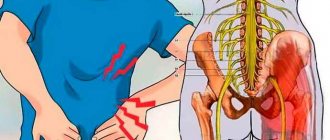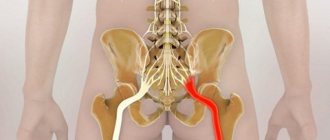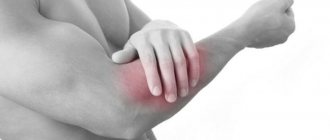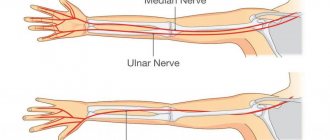13 May 2020
173424
1
3.8 out of 5
Sciatica is sometimes also called lumbosacral radiculitis - a chronic neurological disease in which the sciatic nerve passing through the buttock and leg is compressed. This is accompanied by severe pain and a number of other disorders. It can occur at any age in people of both sexes, often occurs in pregnant women, but is most often diagnosed in people 40–60 years old. Although sciatica is not life-threatening, it can significantly reduce the quality of life and deprive a person of ability to work. Therefore, when the first signs appear, you should contact a neurologist and begin treatment immediately. In this case, it will be as easy as possible, effective and will allow you to quickly eliminate both the signs of the disease and the causes of its occurrence.
What is sciatica
Sciatica is a non-inflammatory disease that occurs due to compression of the sciatic nerve in any area. The concept of “sciatic nerve sciatica” is not used either in the literature or in everyday life, since the term “sciatica” is used exclusively to describe cases of compression of the sciatic nerve and no other.
The sciatic nerve itself is paired and is one of the largest nerves in the human body. Its two branches begin at the sacral nerve plexus, located in close proximity to the vertebrae and sacrum, and run symmetrically along the buttocks, down the back of the thighs and reaching the legs.
The sacral nerve plexus is formed by closely intertwined nerves that run along both sides of the spine from its outer side.
In the upper part of the leg, the sciatic nerve is divided into 2 large branches: the peroneal and tibial. They pass along the back of the lower leg on the right and left.
Thus, the sciatic nerves are quite long, so sciatica can be caused by a huge variety of different causes. And depending on the area where the nerve fiber was compressed, there are 3 types of sciatica:
- upper – the cord or spinal roots at the level of the lumbar vertebrae of the spine are subjected to compression;
- middle (plexitis) – the sciatic nerve is pinched in the area of the sacral nerve plexus;
- lower - pinched nerve fiber is observed in any part along its entire length from the buttock to the foot.
Most often, it is lower sciatica, which is often called neuritis. But since the latter term describes an inflammatory lesion of the nerve, its use as a synonym for sciatica is not entirely correct. Indeed, with sciatica, pain is caused solely by compression of a nerve in one area or another, while with neuritis it can be involved in the inflammatory process or be pinched by hyperemic tissues.
You should not let the course of the disease take its course. Non-intervention and ignoring the symptoms of sciatica is fraught with changes in the lower extremities, which can ultimately lead to loss of performance and the ability to care for oneself independently.
Pinched nerve in the lumbar spine
Numbness of the lower extremities - the causes of this phenomenon lie in a pinched nerve in the lumbar region, accompanied by shooting pain, weakness and limited movement of the leg, tingling and burning in the foot area. As a rule, pain and numbness are felt only in one leg and are aggravated by laughing, sneezing, coughing and sudden movements. How strong the discomfort is depends on the presence or absence of an intervertebral hernia, the presence or absence of an inflammatory process and some other factors.
A pinched sciatic nerve is the most common spinal problem. Most often, the problem occurs due to excessive physical activity or excess weight. In the latter case, treatment should be accompanied by procedures aimed at combating extra pounds. In general, the course of treatment depends on the cause of the disease.
As a rule, traditional methods are used: painkillers are prescribed, movements are limited, and at the next stage massage, acupuncture and physical therapy are used. Spinal traction in the treatment of pinching is also possible at home: “Yalovitsyn’s swing” will help shorten the rehabilitation period and return to an active lifestyle in a short time.
See the price and order the Yalovitsyn swing
Causes
Compression of the sciatic nerve can occur in a variety of different cases. This can occur due to injuries to the legs, pelvis and back, during pregnancy, prolonged immobility, pinched nerves by fibrous cords or neoplasms, etc.
Most often, sciatica becomes a complication of various spinal diseases, including:
- lumbar osteochondrosis - degeneration of large intervertebral discs of the lumbar spine is the main prerequisite for the development of other spinal diseases and pinching of nerve fibers of different sizes;
- the formation of intervertebral hernias is the most common complication of osteochondrosis, manifested by protrusion of the disc, which leads to compression and damage to the spinal roots;
- spondylolisthesis – displacement of the vertebrae relative to the underlying one by different amounts, which can provoke pinching of the nerve roots;
- facet syndrome - nerve fibers are pinched in the narrow natural openings of the spine as a result of deformation of the vertebrae, the formation of osteophytes, or other disorders.
Another common cause of sciatica is spasm of the piriformis muscle located in the buttock. Since the sciatic nerve passes through it, an increase in its tone leads to stretching and irritation of the nerve fiber, which immediately results in severe pain.
Other prerequisites for the development of sciatica include:
- excessive physical activity;
- spinal tumors of various natures from hemangiomas to malignant neoplasms;
- arthritis;
- thrombosis of blood vessels;
- hypothermia and the development of inflammatory processes in anatomical structures adjacent to the spine at the level of the lumbosacral region;
- infectious gynecological and other diseases, including influenza, tuberculosis, typhoid fever, sepsis (released toxins affect the sheath of the sciatic nerve);
- spinal deformities (scoliosis, etc.).
Read also
Senestopathies
Senestopathies are various painful sensations that are almost always difficult to describe by patients, originating from various areas of the body, internal organs, and which cannot be explained...
Read more
Carpal tunnel syndrome
Clinical manifestation of carpal tunnel syndrome This disorder occurs in the median nerve. The causes are tenosynovitis of the flexor tendon in the hands, acute articular rheumatism, pregnancy...
More details
Ankylosing spondylitis/ankylosing spondylitis
Ankylosing spondylitis (ankylosing spondylitis) is a chronic inflammatory disease of the spine and joints, accompanied by progressive pain, stiffness and limited movement at the beginning...
More details
Weakness and numbness in the arm and leg
The appearance of general muscle weakness and numbness in the body, arm or leg is a very serious syndrome, and if it occurs, you should consult a neurologist as soon as possible. Connected…
More details
Multiple sclerosis
Multiple sclerosis (MS) is a chronic disease, contrary to popular belief, completely unrelated to attention disorders and senile sclerosis. In this case, the term “sclerosis” means...
More details
Symptoms
As a rule, the development of sciatica occurs gradually. The first signs are of a mild discomfort and are often perceived by people as a manifestation of banal fatigue after performing physical work. Initially, there may be slight pain in the lumbar region, which radiates to the buttock. In this case, slight discomfort occurs in the leg along the back of the thigh.
The belief of patients that such symptoms are a consequence of overwork and the fact that they occur mainly after physical exertion and disappear without a trace after a short rest are rooted. This condition can persist for several years and is already perceived by the patient as normal.
But sooner or later, lifting an object that is too heavy, hypothermia, or simply careless movement provokes an attack. A person is constrained by pain. It interferes with normal mobility and is often accompanied by autonomic and neurological symptoms.
A specific symptom of sciatica is unilateral pain affecting only one of the buttocks and one leg. As a result of the progression of pathological changes, it increasingly differs in functionality and even appearance from a healthy leg: it is cold to the touch, smaller than healthy, the skin is pale and dry.
The nature of the disorders directly depends on which of the fibers of the sciatic nerve are affected as a result of infringement: motor or sensory. Thus, patients may suffer from:
- decreased sensitivity of the skin of the affected lower limb; sometimes, on the contrary, there is increased sensitivity of the outer edge of the foot;
- muscle weakness in the legs and feet;
- changes in tissue nutrition, which leads to pale skin and thinning;
- disorders of the pelvic organs, which may be accompanied by loss of control over the process of urination and defecation;
- bowel dysfunction, etc.
Sciatica typically has a paroxysmal course with periodic exacerbations.
Manifestations of the disease may vary in intensity and nature. In some cases, acute pain comes to the fore, in others, patients will complain more about limited mobility or other symptoms, mentioning pain only in passing. Thus, sciatica can manifest itself in varying degrees of pain, motor, sensory and neurological impairment. Let's take a closer look at each group of symptoms separately.
Sciatica pain
The nature of pain when the sciatic nerve is pinched can be different. During an attack they are sharp, powerful, burning and shooting. Patients describe them as being struck with a knife or electric shock. Literally any movement or change in body position is extremely painful, and bending or sitting leads to a sudden aggravation of the pain syndrome. Often the pain does not subside even when lying down.
With chronic sciatica, the pain may not be so severe. They are often nagging, aching, present constantly or appear after physical activity. Just as with an attack, they tend to get worse during bending, lifting a leg, or prolonged sitting or standing.
With sciatica, the epicenter of pain is in the lumbosacral spine or directly in the area where the sciatic nerve is pinched. But a typical feature of the disease is the spread of pain along the nerve, i.e., along the buttock, back of the thigh, lower leg, and sometimes even to the toes. To reduce pain, a person takes a forced body position. He leans forward and to the side.
When you try to turn the affected leg bent inward at the hip and knee, a sharp pain occurs in the buttock.
Motor and sensory disorders
The sciatic nerve is formed by sensory and motor fibers. It is responsible for providing sensitivity and mobility to the muscles of the back of the legs. Therefore, when it is compressed, both motor and sensory disorders may occur. They can manifest themselves in varying degrees, be combined with pain or be isolated. In most cases, one or more of the following symptoms are present. Combinations can be different, so different patients with sciatica rarely have the same clinical picture:
- decreased sensitivity of the skin along the lateral and posterior surface of the lower leg and throughout the entire foot;
- the presence of tingling, numbness, goosebumps;
- violations of flexion and extension of the muscles of the back of the thigh and lower leg, which negatively affects the work of the knee and ankle joints and, accordingly, gait (it seems that a person does not bend his leg at all when walking);
- difficulties when bending;
- weakness in the foot, which can literally hang completely motionless on the shin;
- reduction in muscle size due to their gradual atrophy;
- complete paralysis of the muscles of the foot and the back of the thigh and lower leg (with severe sciatica);
- dryness, peeling, thinning, paleness or, conversely, redness of the skin of the lower extremities;
- increased sweating;
- thinning and brittle toenails.
Over time, it becomes increasingly difficult for the patient to walk, since the affected leg loses stability and cannot fully perform its supporting function. There is progressive weakness and lameness.
Impaired nerve conduction can lead to insufficient tissue trophism, which can result in osteoporosis. In such cases, fractures often occur, even under the influence of factors that are normally unable to disrupt the integrity of the bones.
Osteoporosis is a disease in which bone tissue becomes porous, loses its normal strength and becomes brittle.
Symptoms - neurological manifestations
Since the sciatic nerve is pinched in one place or another, this is accompanied by impaired conduction of nerve impulses and a decrease in the intensity or complete loss of reflexes. It is the presence of such symptoms that most often helps a neurologist make the correct diagnosis.
With sciatica, the following are practically not manifested or are completely absent:
- Achilles tendon reflex - a blow with a hammer or the edge of the palm to the Achilles tendon when a person takes a lying position on his stomach normally provokes the foot to move back to a position as if the person is standing on tiptoes;
- knee reflex - hitting a point under the knee with a hammer or the edge of the palm normally leads to extension of the knee joint if a person sits on the edge of the bed with his legs hanging freely;
- plantar reflex - passing the tip of a milk or any other blunt object along a relaxed foot from the heel to the toes provokes its flexion.
Also a clear neurological sign of sciatica is the occurrence of severe pain in the lower back, buttock and thigh when trying to lift a straight leg while lying on your back. When bending the leg, its intensity decreases.
In addition, at some points the sciatic nerve runs very close to the skin: in the subgluteal fold, the back of the knee, the center of the lower leg and in the area of the Achilles tendon. Such points are called Vallee points. Therefore, pressing on them provokes an attack of pain in the presence of sciatica.
Symptoms of a pinched sciatic nerve
- Effective treatment of symptoms of pinched sciatic nerve.
- Dr. Bobyr’s unique method is defanotherapy.
- Reduction of pain after 2–3 sessions.
The sciatic nerve is the largest in the human body; it emerges from the sacral nerve plexus, which, in turn, is formed by five nerve roots: two lower lumbar and three upper sacral. Typically, symptoms of compression occur when the fourth and fifth lumbar and first sacral roots are affected. In addition, pinching of the sciatic nerve itself can occur with piriformis syndrome - we will talk about the main manifestations of this pathology below.
All symptoms of pinched sciatic nerve can be divided into general and specific - occurring when certain nerve roots are damaged. In this case, different roots can be compressed at the same time, which leads to mixed symptoms.
Common symptoms of a pinched sciatic nerve
In most cases, the lesion is unilateral. Nerve compression and, as a result, symptoms occur only on the right or left. The pain that occurs in the lumbar region, goes down to the buttock, then down the back of the thigh.
A list of the most common symptoms that patients complain about when the sciatic nerve is pinched is presented below.
Pain
may be constant or occur periodically. In most cases, patients describe it as sharp, sharp, shooting, reminiscent of a burning sensation. A characteristic symptom: pain when the sciatic nerve and its roots are damaged in the leg is always much more pronounced than in the lumbar spine. On the legs, pain is most often localized in the lower leg area.
Other (uncommon) areas where sciatic nerve pain may occur include:
- The front surface of the thigh, shin.
- Upper and outer part of the foot.
- Sole.
- The membrane of skin between the first and second toes.
A characteristic feature of pain when the sciatic nerve or its roots are pinched is that it can weaken or intensify, depending on the patient’s body position:
| Poses that increase pain | Poses that reduce pain intensity |
|
|
When does leg pain require immediate medical attention?
In rare cases, symptoms may occur that indicate severe damage to the sciatic nerve. They say that the patient needs the help of a doctor as soon as possible:
- Very strong, unbearable pain in the lumbar and sacral area, if it suddenly intensifies.
- Loss of control over rectal and bladder function. It manifests itself in the form of incontinence of stool, urine, imperative urges: when a person experiences an unbearable desire to visit the toilet right now.
- Pain in the lower back and leg is accompanied by nausea, increased body temperature, and causeless weight loss.
These symptoms are dangerous because they may indicate serious conditions such as cauda equina syndrome
(damage to the nerve fibers that extend in the form of a bundle from the end of the spine), infections, benign and malignant tumors of the spinal column.
Muscle weakness
The sciatic nerve is mixed, that is, it contains both sensory and motor fibers. When the latter are involved in the pathological process, movement disorders are observed. Weakness occurs in the thigh muscles, it is felt especially strongly when a person tries to bring his legs together. The patient may have difficulty bending the leg at the knee joint, as well as flexing and extending the foot and its toes.
One of the specific symptoms of movement disorders in certain muscle groups of the legs is stepping
or
"cock walk"
. At the same time, it is difficult for a person to lift his foot; it constantly seems to “fall”. The main manifestations of the step:
- While walking, the patient constantly drags his foot along the ground.
- Severe swaying of the hips, which occurs as a compensatory mechanism: the hip deviates strongly during gait so that the affected foot can rise high enough without touching the ground.
- Climbing stairs and inclined surfaces becomes especially difficult for such people.
In some cases, patients with a pinched sciatic nerve experience difficulty when they try to get up from a sitting position or rise on their tiptoes.
If no treatment is carried out, and compression of the sciatic nerve increases, then muscle strength decreases even more over time. It is worth recalling here that, among other things, nerves perform a trophic function: they influence metabolic processes in muscle tissue. Disruption of innervation leads to the development of atrophy in the muscles: they decrease in volume and “shrink out.” If such a symptom appears, it usually indicates an advanced disease.
Sensory disorders
A decrease in skin sensitivity in the areas of innervation of the sciatic nerve manifests itself in the form of a feeling of numbness. At first it is expressed to a slight extent, and in advanced cases, sensitivity is lost almost completely. As a rule, numbness affects the back surface of the lower leg (in the calf area), heel, sole, and front (dorsal) surface of the foot.
The second type of sensitivity disorders is paresthesia
. This term refers to an unpleasant sensation in the form of tingling, a feeling as if “goosebumps are crawling across the skin.”
Specific symptoms that depend on which roots are compressed
Depending on what symptoms bother the patient, in some cases it is possible to approximately judge in which nerve roots the pathological changes have occurred. Manifestations of sciatica are most often caused by damage to the roots L4, L5 and S1 (two lower lumbar and upper sacral). The table shows common symptoms that occur when each of these three roots is compressed:
| Nerve root involved in the pathological process | Characteristic symptoms |
| L4 (fourth lumbar root) |
|
| L5 (fifth lumbar root) |
|
| S1 (first sacral root) | When this nerve root is damaged, the most classic picture of sciatica (sciatica) develops:
|
Types of clinical course of sciatic nerve compression
Depending on the nature of the primary disease that became the root cause, and some other factors, different types of clinical course of sciatic nerve damage are distinguished:
- Acute sciatica (acute radiculitis).
This term refers to pain along the sciatic nerve that lasts from 4 to 8 weeks. In most cases, such pain can be managed relatively easily with the help of medications from a home medicine cabinet, or they go away on their own without medical intervention. However, it is still worth seeing a doctor - it is necessary to establish and eliminate the root cause of the disease. - Chronic sciatica (chronic sciatica)
is pain along the sciatic nerve, which lasts longer than 8 weeks and does not go away on its own, and remedies from the home medicine cabinet bring only a temporary effect. In such cases, if the pain persists for a long time, it is better not to wait for the symptoms to intensify and complications to develop, but to consult a doctor as soon as possible. If treatment is started promptly, pinched sciatic nerves can be managed with conservative measures. In advanced cases, the risk that the patient will require surgical treatment increases. - Intermittent radiculitis.
This condition is quite rare. With it, pain occurs either in the right or in the left sciatic nerve. This picture is most typical for dysfunction of the sacroiliac joint. - Bilateral sciatica is
another rare condition in which pain and other symptoms occur on both sides. The main causes of bilateral compression of the sciatic nerve:
- serious degenerative lesions of the spinal column at different levels;
- spondylolisthesis
- a condition in which the overlying vertebra slips forward in relation to the underlying one, which leads to compression of the spinal cord and sciatic nerve roots; - Cauda equina syndrome
is a serious complication of various diseases of the spinal column.
Among Western doctors there is such a figurative term as “sciatica of the wallet.” This phrase refers to the symptoms of sciatica that occur in a person when he sits for a long time while there is a wallet or other item in the back pocket of his trousers.
Signs of sciatic nerve compression in piriformis syndrome
The piriformis muscle is one of the muscles of the pelvis. Outwardly, it resembles a fan: its wide part starts from the outer surface of the sacral bone, then its fibers converge, it passes through the greater sciatic foramen (where, in fact, the sciatic nerve passes in close proximity to it), passes into the tendon and is attached to the greater trochanter of the femur bones.
Piriformis syndrome is thought to occur when the muscle compresses the sciatic nerve, resulting in pain and other symptoms of sciatica. The exact causes of this condition have not been studied in detail at this time. The following factors are believed to lead to the development of piriformis syndrome:
- Spasm in the piriformis muscle as a result of irritation of itself, the sacroiliac joint, or other adjacent structures.
- Reflexive contraction of a muscle in response to injury.
- Swelling, which can also be caused by injuries and spasms.
- If there is a hemorrhage in the area of the piriformis muscle.
The symptoms of piriformis syndrome closely resemble the symptoms of nerve root damage in spinal pathologies, and it can be difficult to distinguish between the two conditions. The doctor must carefully examine the patient and conduct a comprehensive examination. Piriformis syndrome is usually diagnosed in cases where other possible causes of pain in the sciatic nerve have been excluded.
The most common manifestations of piriformis syndrome
Most often, such patients complain of acute pain in the buttocks, as well as sciatica-like pain along the back of the thigh and lower leg. The list of typical symptoms of this condition includes:
- dull pain in the buttocks;
- pain that spreads down the back of the leg, in the thigh, leg, foot;
- the occurrence or intensification of pain while walking on stairs and inclined surfaces;
- increased pain during prolonged sitting;
- reduced range of motion in the hip joint;
- increased pain after running;
- improvement and reduction of symptoms in the supine position.
What symptoms can a doctor detect during an examination if the sciatic nerve is pinched?
Research shows that all nerves in the human body normally have a reserve of stretch. In other words, if a person bends or extends a limb as much as possible in various joints, excessive stretching of the nerve passing in this area does not occur, pain or other unpleasant sensations do not occur.
But the situation changes with a number of musculoskeletal diseases, in particular with pathologies of the spinal column and conditions accompanied by pinching of the sciatic nerve. In certain positions of the lower limb, the pressure inside the intervertebral discs increases, and the receptors located in the affected tissues are irritated. As a result, certain muscle groups reflexively, subconsciously tense, and myofication occurs. The patient is in pain. This is the basis for the definition of so-called tension symptoms - the doctor can identify them during an examination.
With lesions of the sciatic nerve, the following symptoms of tension are detected:
- Bonnet–Bobrovnikova symptom
. The patient lies on his back, the doctor takes his leg, passively adducts the hip and rotates it inward. This causes tension in the piriformis muscle and pain. - Lasègue's symptom
. The patient lies on his back, the doctor takes his leg and lifts it, while flexion occurs only at the hip joint, that is, the straight leg is raised. There are three degrees of severity of Lasegue's symptom:
- I degree
- mild pain occurs when the leg is raised approximately 60 degrees. In this case, there is a slight reflexive protective tension in the muscles of the lower back, abdomen, and pelvic area. - II degree
– moderate pain when raising the leg at an angle of 45 degrees. In this case, a pronounced, clearly visible protective tension in the muscles of the lower back, abdominals and pelvis occurs. - III degree
– severe pain when raising the leg up to 30 degrees, sharp tension occurs in many muscle groups.
- Variations of Lasegue's symptom.
Sometimes they are used in emergency situations:
- The patient lies on the couch on his stomach with his legs hanging over the edge. In this case, lowering the leg leads to pain.
- Lasègue's sign can be assessed with the patient in a standing position.
- Vengerov's maneuver: when performing the Lasègue test, contraction of the abdominal muscles can be noted. At the same time, in order to obtain a reliable result, the patient’s attention must be diverted while checking the symptom.
- Bekhterev's symptom
. It is also called Lasegue's cross sign. When the doctor lifts the patient's healthy leg, pain occurs in the affected leg. - Landing symptom
. Pain occurs when the patient tries to sit on a chair or couch with his legs straight. - Dejerine's symptom, or cough impulse symptom
. When the patient coughs, strains or sneezes, he experiences lower back pain. - Sicard's sign
. The patient lies on the couch, the doctor takes his feet and performs strong plantar flexion. This leads to pain along the sciatic nerve. - Turin's symptom
- pain along the sciatic nerve occurs with strong dorsal extension of the big toe. - Razdolsky's symptom or bell symptom
. If you press on the top of the spinous process of the vertebra or on the sides of it, pain occurs that radiates to the leg. - Panov–Lobzin–Churilov marching test
. The patient is asked to march in place while the muscles in the lumbar region are felt. In this case, protective muscle tension is noted.
Symptoms of pinched sciatic nerve in osteopathy
Soft manipulation specialists have some specific approaches to assessing the symptoms of sciatic nerve compression. The doctor always strives to identify the root cause of the disorder, which may be caused by very subtle disorders in the musculoskeletal system.
The task of a specialist in soft manual techniques is not just to relieve the patient of unpleasant symptoms, but to eliminate the disorders that triggered the entire chain of pathological changes that caused these symptoms. For example, it has been established that the cause of sciatica in this particular case is osteochondrosis. But it did not arise on its own. Much earlier, deeper processes began in the body, which provoked degenerative changes in the spine. This may be poor posture, improper muscle tone, impaired blood circulation, lymph outflow, pelvic distortion and excessive tension of the ligaments in certain places, flat feet, changes in the joints of the lower extremities. The doctor must find and work through all these causative factors, this helps to achieve a pronounced and long-term effect.
For doctors practicing defanotherapy - a unique proprietary method developed by Dr. Bobyr - areas of tension in certain muscle groups and ligaments are primarily important. Long-term practice shows that it is excess, pathological stress that often triggers all subsequent pathological changes in the musculoskeletal system.
Treatment of symptoms of sciatic nerve compression
If you are experiencing symptoms of sciatica, you can try to manage them with some home remedies. The first thing that comes to mind is over-the-counter painkillers, which are available in almost every home medicine cabinet. But there are other measures.
Warm compresses and ice packs help a lot. Try applying heat and cold alternately to the affected area for an hour for 20 minutes, after which it will become clear what helps best in your case.
It is a common belief that if a person experiences symptoms of a pinched sciatic nerve or lower back pain, complete rest is indicated. Actually this is not true. You should try to remain physically active within reasonable limits. Stretching exercises can help reduce symptoms of the disease. Ask your doctor how to perform them correctly.
Often, these simple methods help to successfully cope with the symptoms of sciatica and return to a full, active life.
But even after the pain has passed, it is worth visiting a doctor. It is not enough to just eliminate the symptoms. If the cause of the disease is not treated, the pain may return, and even stronger than before. The Bobyr clinic employs experienced specialists who will help identify the disease that causes pinching of the sciatic nerve and prescribe effective treatment. Author: K.M.N., Academician of the Russian Academy of Medical Sciences M.A. Bobyr
Diagnostics
A neurologist diagnoses and treats sciatica. It is this specialist who should be contacted if any of the above symptoms occur. Already during the first appointment, based on the patient’s complaints and examination, the doctor may suspect compression of the sciatic nerve. But in order to find the most effective treatment, you need to find out why this happened. For this purpose, the patient is prescribed a set of studies, thanks to which the condition of the intervertebral discs, joints, bones, etc. can be assessed.
Therefore, as part of the diagnosis of sciatica and the causes of its occurrence, the following are used:
- X-ray of the sore leg, sacrum and lower back - the results of the study show the condition of the vertebrae and partly the intervertebral discs;
- MRI – provides comprehensive information about the condition of the intervertebral discs and spinal cord;
- CT is an informative method that allows you to detect pathologies of the sacrum and lumbar vertebrae;
- Electroneuromyography – provides data on the quality of transmission of nerve impulses to the muscles of the lower extremities and their contractility.
The most informative method for diagnosing diseases of the cartilage tissue from which intervertebral discs are formed, as well as pathologies of the spinal cord, is MRI. It is this method that allows you to thoroughly examine the discs, assess their size, position, and detect the slightest hernia and other disorders.
Pinched nerve
5/5 3 votes.
Article written according to scientific standards and reviewed by a medical professional
This text is consistent with medical literature, medical guidelines, and current research and has been reviewed by medical professionals. Sources and author.
A pinched nerve is a rather unpleasant sensation that is accompanied by pain, tingling, or even numbness. This occurs due to compression, and as a result, irritation or damage to the peripheral nerve. Moreover, almost any nerve in the human body is sensitive, which means it can cause such discomfort.
pinched nerve symptoms
Symptoms of nerve compression
If you have a pinched nerve, you may not recognize the problem right away. The fact is that at first you will feel a slight tingling sensation. Later, numbness and insensitivity may appear in the affected area. And if the pressure on the nerve is really strong, the condition will not improve, but on the contrary, the pain will become constant, the tingling will become “sharp”, similar to an electric current. There may even be a burning sensation.
In more complex cases, they talk about muscle weakness, which is fraught with further problems with the affected muscles, up to their reduction and limitation of their functions.
© medicinenet.com
Damage Locations
Where and what nerves can be “pinched”?
- In the cervical spine. In this case, you will feel pain and tingling in your arms and shoulder blades.
- In the elbow joint . Quite often, people with sedentary work face this problem, when they have to constantly lean on their elbows.
- In the carpal tunnel , when the median nerve is damaged.
- Damage to the external cutaneous nerve of the thigh (Roth-Bernhardt disease) with possible pain during movement, or even while lying down. Pregnant women often encounter this problem when the nerve “suffers” due to an enlarged uterus.
- Sciatica is a pinched sciatic nerve, with pain “radiating” to the leg or thigh.
- Compression of the peroneal nerve caused by crossing the legs at the knee.
Risk zone: who is at risk of being pinched?
A pinched nerve can be caused by poor posture and body position, as well as accidental injuries. Also at risk:
- Patients with arthritis in the spine or a herniated disc;
- Overweight people: Weight gain or water retention can also cause pinched nerves;
- Patients with thyroid diseases;
- Pregnant;
- Workers who constantly perform the same type of work - the same repetitive actions over a long period of time can cause swelling of the nerves and, as a result, their pinching.
pinched nerve causes
Diagnosis and treatment
If a nerve is compressed for a short period of time, it can repair itself. It may also take several weeks or months for symptoms to completely subside. But if compression persists for a long time, it can lead to permanent nerve damage.
To determine how serious the problem is, sometimes a simple examination by a doctor is enough. But additional diagnostics may also be required, which include:
- Electromyography is a nerve conduction study that helps confirm the diagnosis of a pinched nerve and determine the extent of nerve damage.
- MRI or CT if the pinched nerve is in the neck or back.
The treatment for a compressed nerve depends on the location of the problem and its cause. Typically, such patients are advised to rest and avoid physical activity. Physical therapy can also be helpful, especially if the compressed spinal nerve is caused by problems in the neck or lower back. Proper exercises to strengthen the muscles and relieve pressure on the nerve can help. Non-steroidal anti-inflammatory drugs or corticosteroid injections are also usually prescribed. If you are talking about carpal tunnel syndrome, you will most likely be prescribed splinting or bracing of the wrist. Weight control is also recommended for all patients with pinched nerves.
As a last resort, if the diseased nerve does not respond to conservative treatment, surgery may be necessary. The type of surgery depends on which nerve is being treated.
A pinched nerve is a fairly common problem. And so that you don’t have to face it, it’s better to take care of prevention. And this includes proper nutrition, weight control, an active lifestyle, and the ability to take breaks at work, especially if one is the same type and depressing. More self-love and as little incorrect body positions, incorrect posture and injuries as possible. Then your health will be at its best and you won’t have to look for the cause and deal with the consequences of nerve compression.
Make an appointment with a specialist
Still have questions? Ask!
Sources
- medicinenet.com
- mayoclinic.org
- webmd.com
+0-0 0 vote.
Conservative treatment of sciatica
One can hope for a lasting improvement in the condition and elimination of pain in the buttock, back of the thigh and lower leg only if the factor that caused the pinching of the sciatic nerve is eliminated. Otherwise, all attempts to improve the patient’s condition will either be ineffective or will produce a weak, short-term effect. The modern level of development of medicine makes it possible to eliminate, conservatively or surgically, almost any disorder that provokes compression of the sciatic nerve. But the sooner they are detected and treatment started, the better the prognosis will be.
Therefore, patients are always prescribed complex treatment, consisting of symptomatic and etiotropic therapy, selected according to the detected cause of sciatica. In this way, it is possible to improve the patient’s condition and eliminate the risk of relapse of the disease.
In most cases, conservative therapy is initially prescribed. Only in particularly advanced cases, when severe pathologies of the spine are detected, is surgical intervention immediately recommended to the patient. As part of conservative treatment, patients are prescribed:
- drug therapy;
- physiotherapy;
- exercise therapy;
- manual therapy.
Also, with sciatica, wearing fixation belts has a positive effect on the patient’s condition.
But conservative therapy, unfortunately, does not always give the desired results and in certain cases it is impossible to eliminate the causes of sciatica without surgery. Then patients are recommended to undergo surgical intervention appropriate to the situation.
Drug therapy
Directly to improve the patient’s condition with sciatica, the following are prescribed:
- NSAIDs and non-narcotic analgesics are used to relieve pain, and drugs from the NSAID group additionally provide an anti-inflammatory effect;
- corticosteroids - used to eliminate severe inflammatory processes and quickly reduce the swelling of soft tissues caused by them;
- muscle relaxants – help eliminate muscle spasms that occur in response to attacks of pain and help break the vicious circle of “pain - spasm - pain”;
- antioxidants, B vitamins - are used to improve tissue trophism and normalize nerve conduction along the sciatic nerve, which allows for improved sensitivity and elimination of numbness;
- angioprotectors and microcirculation stimulants - help improve microcirculation, and therefore prevent muscle atrophy and restore the sciatic nerve;
- metabolic drugs - used to improve the quality of nutrition of nerve fibers and their restoration;
- products for topical use - ointments with bee, snake venom, other warming and irritating substances, as well as containing NSAIDs, help reduce pain and stimulate local blood circulation.
If, despite conservative therapy, acute pain does not go away or a new attack occurs, patients may be given novocaine or lidocaine blockades. Such procedures are performed only in a medical facility, since they require compliance with sterile conditions and thorough mastery of special skills. When performing a blockade, anesthetics are injected directly into the area where the nerve bundles pass. This prevents the passage of painful nerve impulses and quickly leads to improvement. But the blockade does not affect the causes of pain, but only temporarily eliminates them.
In severe cases, when pain is not relieved by any other methods, patients are prescribed opioid analgesics. They are taken in short courses under the supervision of a doctor, as they quickly cause addiction and drug dependence.
Etiotropic therapy is selected strictly individually based on the nature of the detected pathologies. So, for example, when infectious diseases are detected, treatment will necessarily include antibacterial and antiviral agents, etc.
Physiotherapy
Physiotherapeutic procedures are widely used for sciatica. They help to activate blood circulation in the affected area, reduce pain, restore sensitivity and relieve swelling. The most effective are:
- diadynamic currents;
- darsonvalization;
- laser therapy;
- magnetic therapy;
- UV therapy;
- ultrasound therapy.
Electrophoresis is often indicated for sciatica. The essence of the method is to deliver drugs directly to the right place using electric current. This ensures a pronounced therapeutic effect and rapid improvement in the patient’s condition. Using electrophoresis, anti-inflammatory, antispasmodic agents, as well as muscle relaxants can be injected into the area of compression of the sciatic nerve.
Exercise therapy
Physical therapy for sciatica plays an important role. A properly selected set of exercises allows you to relieve muscle spasms, activate metabolic processes and thereby speed up the process of nerve fiber restoration and eliminate soft tissue swelling.
The exercise therapy program is selected for each patient individually, taking into account the nature of the existing spinal pathologies. Therefore, only a specialist can cope with this task.
For sciatica, most exercises are recommended to be performed lying on a hard surface. Initially, the doctor selects light exercises and requires a small number of repetitions. The first classes are conducted under his supervision so that the patient can fully master the correct technique of the proposed exercises and continue to practice independently.
Gradually, the complexity of the exercises is increased and the load is increased in order to achieve optimal results. But this can also only be done under the strict supervision of a specialist.
It is necessary to do exercise therapy every day. Exercises are performed slowly, without sudden movements. And if pain occurs, you should immediately stop exercising and consult a doctor.
Manual therapy
Properly conducted manual therapy sessions increase the effectiveness of the treatment and contribute to a rapid improvement in the condition. The use of special techniques of manipulation, mobilization, post-isometric relaxation and others can not only improve blood circulation in the affected area and relieve muscle spasms, but also normalize the position of the vertebrae, increase the distance between them to normal levels and release pinched nerve fibers. This quickly leads to relief and normalization of the patient’s condition.
But manual therapy sessions can only be trusted by qualified specialists, since incorrect movements or lack of understanding of the effects on the spine in certain diseases can cause significant harm and provoke the development of unwanted complications.
Sciatica is not uncommon during pregnancy. But due to the fact that during this period the use of most medications is unacceptable, manual therapy is one of the main ways to relieve pain and improve the condition of women before childbirth.
Treatment of pathology
Based on the diagnostics performed, the cause of the numbness is identified. The specialist leading the treatment will draw up a course of therapy using medicinal or non-medicinal methods. The full course may include:
- Taking medications. NSAIDs and steroids effectively eliminate numbness. Complex drug therapy uses painkillers, chondroprotectors, muscle relaxants, vitamin-mineral complexes, drugs that activate blood circulation;
- Ointments, gels, creams. The affected area is rubbed with elements of massage, and then medicinal compositions are applied. The products are used once, less often twice a day;
- Diet. The diet is enriched with foods containing B vitamins.
- Physiotherapy. Methods are used that activate blood circulation, metabolic and regenerative processes in tissues. Currents, magnetic therapy, ultrasound and low-intensity laser radiation are widely used.
- Traditional methods. Used only with the permission of the attending physician. Wraps with honey and camphor alcohol, rubbing, baths based on medicinal decoctions are shown;
- Exercise therapy. A set of exercises is selected individually by a physiotherapy specialist, taking into account concomitant diseases, age and current condition of the patient. Classes must be carried out daily, preferably 2 times for 40-50 minutes;
- Surgical intervention. Manipulations are performed according to the identified diagnosis. Traumatic injuries, neuropathy, damage to the nervous system, and vascular anomalies are promptly corrected.
Surgery
The operation is indicated if conservative therapy is ineffective and severe pain that cannot be eliminated by conservative methods persists for more than 6 weeks, as well as in the presence of:
- large intervertebral hernias;
- spondylolisthesis;
- spinal deformities;
- hemangiomas, chondromas and other spinal tumors;
- severe dysfunction of the pelvic organs, leading to urinary or fecal incontinence.
In such situations, conservative therapy will, at best, slow down the development of these pathologies, but not eliminate them completely. But if in the isolated existence of, for example, an intervertebral hernia, this is enough to improve the patient’s condition, then in cases where the presence of spinal pathology provokes the addition of sciatica, such measures will not be enough.
After all, the cause of the pinched sciatic nerve remains, it continues to suffer and cause the corresponding clinical picture. Therefore, in such cases, surgery is the only way to achieve a lasting improvement in the condition, restore a normal quality of life and eliminate the risk of loss of ability to work.
But even if there are indications, surgical intervention cannot always be performed. It is contraindicated for:
- pregnancy;
- infectious and inflammatory diseases;
- decompensated diabetes mellitus;
- serious respiratory or heart failure.
A timely operation can completely eliminate the causes of sciatica.
Surgical treatment of sciatica for intervertebral hernias
Herniated discs are a common cause of sciatica. Moreover, the severity of symptoms of nerve entrapment does not always depend on the size of the protrusion. Sometimes even small hernias can cause serious pain, limited mobility and neurological disorders.
Today, the problem of intervertebral hernia can be completely solved only by surgery, but the type of operation directly depends on the size, location and other features of the hernia. For small protrusions, preference is given to percutaneous surgical methods: nucleoplasty and hydroplasty.
In both cases, the essence of the operation is to destroy part of the nucleus pulposus of the disc, which leads to a reduction in the size of the hernia or even its retraction due to the creation of reduced pressure inside the disc. Percutaneous surgery techniques involve the use of thin cannulas, the diameter of which does not exceed several millimeters.
Operations of this type can be performed under general or local anesthesia. The instruments are inserted into the disc under the control of the image intensifier, which allows the neurosurgeon to precisely control the direction and depth of needle insertion, and also practically reduces the likelihood of injury to nerves or large blood vessels to 0.
Using cold plasma, radio waves, thermal laser energy or liquid pressure (during hydroplasty), part of the nucleus pulposus is destroyed. The volume of intervention is clearly controlled by the surgeon. Once the desired effect is achieved, the cannula is removed, and the remaining postoperative wound does not even require sutures. It is covered with a sterile bandage, and within a few hours the patient can leave the clinic and return to daily activities.
But nucleoplasty and hydroplasty are effective only for hernia sizes up to 0.7 cm. In other cases, other methods are used:
- Microdiscectomy – involves removing the hernia through an incision of about 3 cm in the projection of the affected disc. Special miniature instruments are used to perform the operation. Microdiscectomy allows you to remove a hernia of almost any size and location, while the small size of the incision ensures ease of rehabilitation and speed of recovery.
- Endoscopic surgery is a gentle method of surgical treatment of intervertebral hernia, which involves removing it with special instruments that are inserted into the patient’s body through punctures up to 1 cm in diameter. Through endoscopic surgery it is also possible to remove almost any hernia, but if its location is complex, the technique is powerless.
Surgery for sciatica caused by spondylolisthesis
Surgical treatment is indicated for spondylolisthesis, accompanied by a displacement of the vertebra by more than 50% relative to the normal axis. It can be carried out in two ways, and the choice of a particular one is based on the results of the MRI. But with sciatica, stabilization of a displaced vertebra in a normal position is permissible only after removal of the anatomical formation that provokes compression of the nerve and the development of neurological symptoms of sciatica.
In almost all cases, stabilization of a displaced vertebra is carried out using a special plate, which is fixed to a healthy and slipping vertebra using screws. This eliminates the possibility of it being re-displaced from its anatomically correct position. But first it is necessary to carry out:
- Discectomy – removal of the intervertebral disc is indicated if, against the background of spondylolisthesis, an intervertebral hernia forms and impinges on the spinal root. If complete removal of the disc is required, it is replaced with an endoprosthesis or a graft of the patient's own bone. The first option is preferable, since modern endoprostheses are in no way inferior in functionality to natural intervertebral discs.
- Foraminotomy - is performed when a nerve is pinched in the foraminal openings of the spine as a result of a decrease in their size due to the proliferation of bone tissue or other reasons.
- Laminectomy is a radical operation used only in extreme cases when spondylolisthesis has led to stenosis of the spinal canal. During a laminectomy, both individual anatomical structures and entire vertebrae can be removed. In the latter case, the removed vertebra is replaced with appropriate implants.
Surgery for sciatica caused by scoliosis
Scoliotic deformity of the spine often provokes pinching of various nerves and the development of sciatica in particular. Therefore, if the deformity cannot be corrected conservatively, surgical intervention is resorted to.
There are several types of operations performed for scoliosis. The specific tactics for restoring the correct axis of the spine are determined individually, but in all cases special metal structures are used that fix the vertebrae in the correct position. Sometimes they involve correcting the position of the vertebrae after surgery with gradual tightening of the screws to form a more correct axis of the spine.
But if previously all operations to correct scoliosis involved long incisions along almost the entire length of the spine, today this is possible even in a minimally invasive way. As a result of eliminating spinal deformity, the nerves are freed, which helps eliminate the causes of sciatica and progressively improve the patient’s condition.
Prevention of sciatica
In fact, avoiding the development of sciatica is much easier than then suffering from unbearable pain and undergoing treatment. To do this, as well as to avoid relapse of the disease after successful treatment, it is enough to lead a healthy lifestyle and follow simple rules:
- maintain the level of physical activity at an optimal level (daily walking, morning exercises and visits to the pool 2-3 times a week are enough to maintain normal muscle tone and improve the condition of the whole body);
- take breaks every hour when working sedentarily and use an orthopedic corset if you need to sit for a long time;
- purchase an orthopedic mattress that will not sag under body weight;
- observe the correct technique for lifting heavy objects: with your knees bent and your back straight;
- refuse strong physical activity;
- normalize your diet and avoid overeating.
Thus, it is possible to cope with sciatica, improve the quality of life and avoid the risk of losing the ability to self-care at almost any stage of development. But it is much easier to do this when the first symptoms appear. Otherwise, the likelihood of needing surgery is very high.










